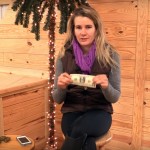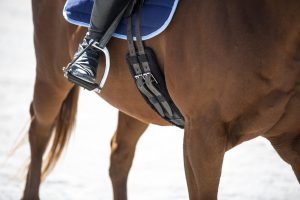As a horse trainer, I think about behavior all the time. Why are the horses I work with acting like this? How can I change it, how can I teach them or motivate them to do something different?
The answers are often both simple and complex at the same time.
A truth I have come to understand is that, on a basic behavioral level, we aren’t that different from our horses. As humans we may have more cognitive ability, we may be able to reflect on the past or imagine the future, but our day to day behavior is influenced and shaped the same way as our horse, our dog, or the sparrow outside.
We all do more of what makes us feel good. It’s called reinforcement. This is the simple part.
Where it gets more complex is that there are different types of reinforcement and what feels good to one individual (horse, person, dog) may feel terrible to another.
I’ll explain in this week’s video. Hit play below.
I’m excited to read your comments on this one!
Scroll down and share your “reinforcement list”.
See you in the comments,
Callie
p.s.
Here are the other links mentioned in this video:















13 Responses
Yes, every horse is so different! I have two horses that respond to opposite things. I have to be a different person for each horse. My gelding responds well to food, freedom, and play. I reinforce with treats, letting him have as much space and freedom to express himself, and I make everything into a high energy game where he doesn’t even realize he’s learning something. For him, FUN is the reward! My mare does well with lots of reinforcements in the forms of release, calmness, and direction. She needs time to process and think through new things and then go back and try again. She can get very scared and my steady calmness calms her and reinforces to her that being clam is a nicer feeling than being stressed out. She likes me to lead her and show her what to do. This also reinforces learning calmness. Feeling safe and secure with me is her reinforcement.
Positive reinforcement for my horse is hay, food and petting. Probably the most common for all horses lol
Love this video, Callie. It got me thinking; my gelding, Beckham, may not see my scratching or touching after he completes a task well as a reward at all, but maybe a punishment! Remember, he came to me as a biter, now a slight nipper and getting better every day but I have noticed his agitation when I touch his neck after clicking and rewarding his behavior with a piece of carrot. Perhaps I should start refraining from the touching part for a while and wait until he “invites” me to touch him instead of assuming he enjoys it. He is sensitive (an OTTB with ulcers when I got him a year ago and another case of ulcers recently) so touching may not feel as good to him as I think at times. There are occasions when he loves when I touch him and use the curry comb on him in a circular fashion while he grazes but while training him, he isn’t always that receptive to my touch to his neck. Hmmm….I am learning to pay better attention to his signals and your video helped me to bring to the forefront my suspicions. Thank you!
That is a great observation Allison! One of the horse’s here, Bandit, is similar – he doesn’t like touch and despises grooming. I pay a lot of attention to how I touch him, because a firm stroke or firm scratching at his withers he is ok with and if relaxed he can seem to enjoy. But a passing pet on the head, or a pat on the neck, or too light touching that tickles him he hates!
When training i use a clicker and treats as well as pressure/release. The combination works well for me but the most amazing thing i have observed is this: keoni my 8 year old arabian mare understands that specific behaviors earn her a reward. So when she wants a treat, she does not try to help herself to my treat bag or push me around. What she does is go thru the repertoire of what she has learned in hope that i will reward her. It is fascinating to watch. She will bend her head and wait, if that does not work, she will back up on her own, if no response she will flex her neck and stay flexed while looking at me. I did not anticipate this! What i do when this happens, is just go thru a review of what she knows and reward at random then add a new behavior that i reward consistently with a treat. Because in a way she is asking for a treat, but at the same time she is saying: i am willing to work for it. Amazing! I watch your videos religiously and i am so grateful. I have learned so much. A huge thank you!
Reinforcements:
Me:
primary – time with my horse
secondary – house chores done for the day
Wildfire (my horse):
primary – treats
secondary -sound of velcro on treat pouch
Riley (my dog):
primary – love & attention
secondary – sound of my key in the lock
I’m glad you clarified primary and secondary. I would have thought them to be the reverse.
Callie, I would like to know what you might considering be primary and secondary to successfully catching and bringing the horse in from the field. I give my girl a treat once I tie her in the tack up area and I rarely have a problem catching her. My husband will give his horse a carrot when he gets close enough to him, before he has the halter on or even a rope over his neck and he frequently has to chase before he catches. I’m pretty sure he would do better not to treat until he at least has a lead and halter on his horse- correct(?) (He doesn’t believe me!)
I give a piece of carrot to the first horse that approaches me, not the late comer (unless they both come at the same time-then both are rewarded). Now, they both approach because they know I always have a reward for their approach. Another important point is to make sure you spend time with them in their pasture just hanging out with them while they graze. I carry a halter and rope with me each time, even if I’m not planning on using it just so they are always used to seeing it with me. I’ll sit down and watch them then approach and scratch their withers then retreat and hang out for a bit then leave. They have no idea if I’m there to take one or just there for a visit. Hope this helps!
I like the idea of “hanging out” in the field with them. That could be very helpful.
Giving a carrot to the first one who comes won’t probably work so well in a field with 29 horses in it!
Hi Shanna! The treat is almost always going to be the primary reinforcement. But what I would do in this situation is to give a few treats. Treat for the approach, the rope around the neck, and the halter going on. Then once the catching process is easier, you can make the process more random. Also, as Allison mentioned in her comment, I have found too one of the best ways to help horses become easier to catch is to not catch them every time I go in the field, but to just go out and pet, scratch, etc.
Thanks, Callie, we’ll try all of the above.
Forgot one important key, never show the carrot to entice them to come to you. Just keep it in your pocket and give it when they come to you as a special reward. They catch on real quick!